Music, Saurians and Colored Fire at the Crystal Palace
by Tori V. Martínez
Chances are, most visitors to London are under the mistaken
impression that the city's iconic Crystal Palace is a place to be
found only in history books, not on the tourist routes. That is,
of course, if they've actually even heard of the Crystal
Palace.
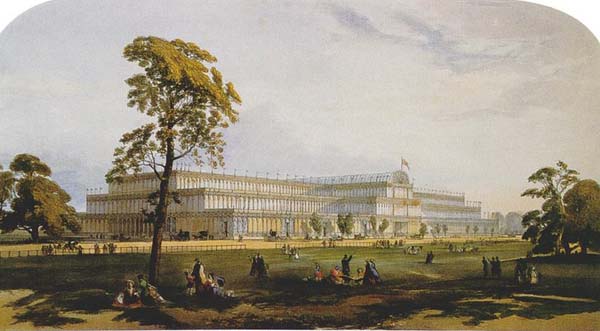
Even for those in the know, the unique glass and iron
structure is most often associated with the building in Hyde Park
that housed the Great Exhibition of 1851, the first World's Fair.
But that incarnation lasted just six months -- a mere pittance
compared to the 82 years it stood in southeast London where it
served as the city's hub of culture and entertainment. And
although it burned to the ground in 1936, both the spirit and
numerous physical reminders of the Crystal Palace can still be
found just a short journey outside central London.
The World in London
On June 10, 1854, Queen
Victoria dedicated the new Crystal Palace in Sydenham, just as
she had done for the original Crystal Palace in Hyde Park only
three years earlier. A more perfect spot could not have been
chosen to do justice to the very successful original exhibition
building. At 380 feet above sea level, the location is the
highest point in southeast London. The completed building was so
prominent that it could be seen from Hampstead Heath some 12
miles away.
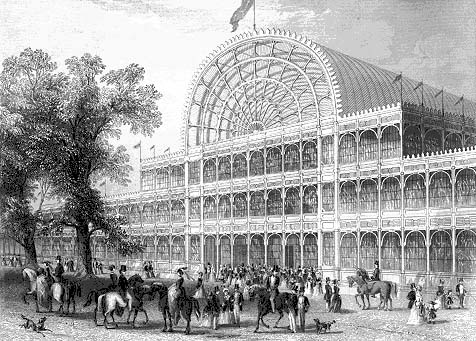
Although the original structure designed by Joseph Paxton was
theoretically disassembled in Hyde Park and reassembled in
Sydenham, the new version had actually been significantly altered
and expanded by Paxton himself. Half again as big as the
original, the new five story building boasted 843,656 square feet
of floor space and was comprised of around 1,600,000 square feet
of glass. The Sydenham Crystal Palace, announced The Times
in London, had "transcended the original."
But there was more to the new Crystal Palace than just the
building. According to the 1970 book, The Crystal Palace,
the original purpose of the park and building was to provide
"Londoners the opportunity to expand their knowledge of the
world while relaxing in lovely surroundings." To meet this
end, the inside of the Crystal Palace displayed the best elements
of world culture and history alongside all the greatness and
wealth of the British Empire. Outside, the early highlight of the
sprawling park was a system of "Grand Waterworks"
designed by Paxton to rival those at Versailles and featuring two
main jets that shot water up around 280 feet high.
An American author, Maria Susanna Cummins, visited the Crystal
Palace in 1860 and described it in a letter to her mother:
You must imagine an immense & beautiful glass
structure covering fifty times the space of any building you ever
saw -- an approach through a terraced garden with temples, vases,
fountains & sculptures in stone & marble.
Every country & climate, every thing, almost in the world, is
represented in these different alcoves. Now you are in the
Alhambra, now in Nineva, now in Australia, life-like figures,
ancient sculptures & architectures, strange animals (stuffed
-- or moulded to life) & flowers & plants appropriate to
each land help out the illusion."
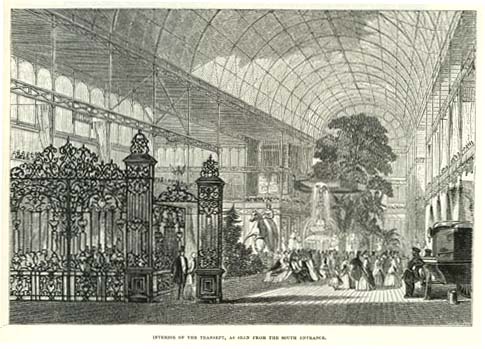
Plenty of others were equally impressed. Between 1854 and
1886, almost 60 million visitors toured the Crystal Palace.
Considering its popularity, it's not surprising that many
historic "firsts" took place there over the years. The
earliest of these was the world's first "theme park,"
which opened in 1854 and consisted of life-sized models of
dinosaurs set on islands surrounded by appropriate vegetation and
geological illustrations. In 1902, an amusement park with water
rides and a looping rollercoaster called the Topsy-Turvy was
added. A much darker first was attributed to the Crystal Palace
on August 17, 1896 -- the world's first motor vehicle death.
Bridget Driscoll, 44, was killed on the grounds of the Crystal
Palace when a car offering demonstration rides to the public hit
her while traveling just 4 miles per hour.
Visitation waned by the early 20th century, but the Crystal
Palace still had tremendous draw and was constantly being adapted
and reinvented in various ways. In 1905, the Crystal Palace
Football Club was founded there and was based at the park until
1915. Another great exhibition, the Festival of Empire
Exhibition, was held at the Crystal Palace in 1911. During World
War I, the site was used for naval training, and when it was
reopened to the public in 1920, it housed the Imperial War Museum
until 1923.
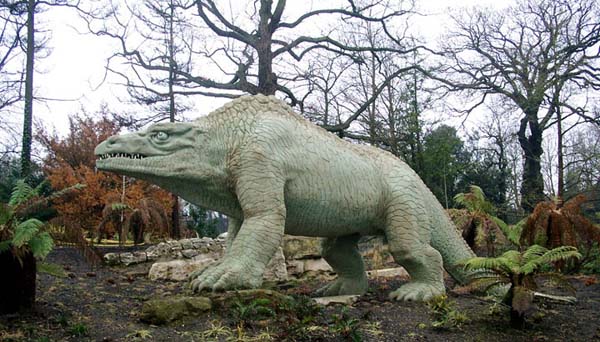
Despite or because of the many transitions, the Crystal Palace
never ceased to inspire a sense of awe. Even 70 and 80 years
after its creation, it was still heralded as a modern marvel, as
when an American newspaper enthusiastically reported in 1927 that
"the Crystal Palace, one of the largest amusement halls in
the world, is famous for its roof with 25 acres of glass."
Unfortunately, there were definite signs that the Crystal Palace
was being neglected, even in its early days, starting with
Paxton's grand waterworks falling into disuse and disrepair. More
critically, fire became a persistent threat as small blazes
caused by discarded cigarette butts were regularly put out on the
site. In December 1866, a larger fire destroyed a portion of the
building known as the north transept, which was never rebuilt. In
the 1920s, at least two more fires damaged part of the Theatre
and portions of the south wing. But these were all minor in
comparison with the conflagration that finally destroyed the
Crystal Palace on the night of November 30, 1936.
Contemporary accounts describe how the red glow of the fire was
so strong that it could be seen some 50 miles away in Brighton.
When the fire caused the central transept to collapse, the sound
could be heard five miles away. It took 438 firemen to fight the
blaze, albeit unsuccessfully, and 749 policemen to protect the
massive crowds -- estimated between 100,000 and 500,000 people --
that gathered to watch the fire.
Local residents still pass down stories of molten glass
collecting in pools around the burning structure. A modern
account confirms these stories and describes the scene:
The massive iron skeleton shimmered in the searing heat and
pools of molten glass filled the famous historic courts.
Goldfish, which had once graced the ornamental ponds, were
reported by The Times as 'missing -- believed boiled'. Whole
panes of glass were blown out of the roof by the updraught only
to come crashing down again in nearby streets. Vivid tongues of
yellow flame leaped 200 feet into the night sky."
By first light on December 1st, very little of the great Crystal
Palace remained.
Beyond Iron and Glass
In a letter to the editor appearing in The Times on
December 4, 1936, a local resident recalled: "I remember
[the Crystal Palace] as the music centre of London; the exquisite
beauty revealed there in coloured fire can never be forgotten; to
roam among the Saurians was a delightful reminder of days when
food was plentiful upon the earth and the beasts could indulge
their appetites."
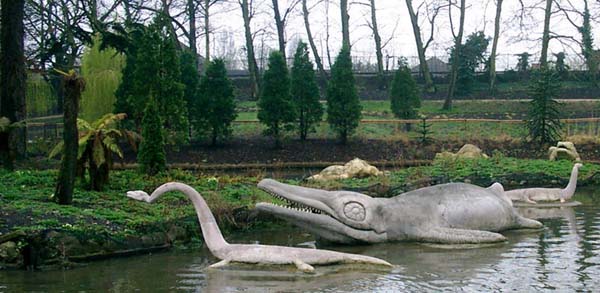
Although the iron and glass of the Crystal Palace are long
gone, the Crystal Palace Park is once again a music center of
London and still retains many original and recreated features and
elements, including the "Saurians" (dinosaurs) and
"coloured fire" (fireworks) lamented as forever lost 70
years ago. In 2003, the original dinosaur park was reopened to
the public after a £4 million restoration. And the modern
fireworks displays that take place regularly in the park echo the
famous Brock's fireworks displays that ran from 1865 until 1936.
Other remnants of the Palace are the original Italianate terraces
featuring a few of the original Classical-style statues, two
stone Sphinxes, the original boating lake, and a recreation of
the original maze that opened in 1870. Evidence of the Crystal
Palace can even be found in the homes that still surround the
site. At the Melrose House Bed and Breakfast in nearby Penge, an
urn exactly matching one displayed in the original Exhibition
catalog graces the garden of the Victorian house.
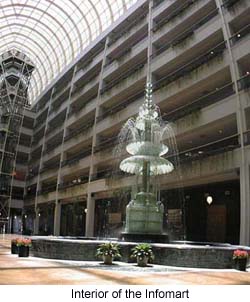 Modern additions to the Crystal Palace Park include
the 722 foot high television tower built in 1957, and The Crystal
Palace National Sports Centre, which was built in the park in the
1960s and is used for a variety of sports training and events.
The park is also home to a number of other attractions, including
a farmers market, an annual summer "Victorian Weekend,"
and an ice rink in December and early January. The Crystal Palace
Museum is housed in the former Crystal Palace School of
Engineering building, which was founded in 1872. Modern additions to the Crystal Palace Park include
the 722 foot high television tower built in 1957, and The Crystal
Palace National Sports Centre, which was built in the park in the
1960s and is used for a variety of sports training and events.
The park is also home to a number of other attractions, including
a farmers market, an annual summer "Victorian Weekend,"
and an ice rink in December and early January. The Crystal Palace
Museum is housed in the former Crystal Palace School of
Engineering building, which was founded in 1872.
A giant marble bust of Sir Joseph Paxton by W.F. Woodington,
originally unveiled in 1873, still graces the park, although --
strangely -- it was repositioned in more recent times to face the
sports center rather than the former site of the Crystal Palace.
Not far from Crystal Palace Park, near the Caravan Club
campground is a blue plaque that marks the former location of
Rockhills, the home of Paxton from 1852 until his death there on
June 8, 1865.
From a historical standpoint, the Sydenham Crystal Palace still
attracts tremendous interest. In 2004, 47 photographs of the
interior and exterior of the building taken in the late 1850s
were purchased by English Heritage for £13,500 -- nearly
three times more than expected. It has also been of architectural
interest as far away as Dallas, Texas, where it inspired the
creation of the seven-story, 1.6 million square foot INFOMART.
Built in 1985 as a high-tech business and market center, the
INFOMART's early promotional materials boasted that the British
Parliament had recognized the structure "as the official
successor to the Crystal Palace."
Back in London, the many reminders of the Sydenham Crystal Palace
are an easy 15 minutes train journey from Central London. Modern
day visitors can even travel to the site of the Crystal Palace
from Victoria Station or London Bridge Station and arrive at the
same low level railway station that was originally opened in
1854.
More Information:
We regret that we no longer have the resources to maintain up-to-date links and/or hours and pricing details for the various sites and attractions listed on this website. For more information about the location(s) listed above, please use your favorite search engine or visit Wikipedia.
Tori V. Martínez is a writer and freelance public relations professional who spends as much time as possible researching and writing on her favorite subject -- history. Several years ago, Tori eschewed the life of a full-time career woman to travel and live around the world, particularly in Britain, where she spent considerable time exploring and researching historic destinations. At the moment, she is living in the US with her husband -- a Spaniard she met in England -- and is happily writing for a variety of online and print publications.
Article © 2006 Tori V. Martínez
Dinosaur photos by Colin Gregory Palmer, courtesy of Wikipedia.org
|
